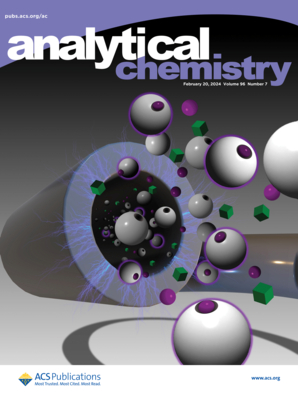Photoelectrochemical Biosensor Based on TiO2/P5FIn with a Cascade Amplification Strategy for Simultaneous Detection of GSH and E2 Analytes of Ovarian Cancer
IF 6.7
1区 化学
Q1 CHEMISTRY, ANALYTICAL
引用次数: 0
Abstract
In this work, a photoelectrochemical (PEC) sensor for ovarian cancer detection was constructed based on TiO2/poly(5-formylindole) (P5FIn)heterojunction using cascade amplification. The combined detection of multiple markers instead of a single detection mode can improve diagnostic accuracy. The photoelectron conversion efficiency and photocurrent response were significantly improved by the reaction of the detector glutathione (GSH) with cystine. 17β-Estradiol (E2) had a negative effect on the PEC response, reducing the photocurrent signal, and ultimately realizing the sensitive detection of GSH and E2. The PEC sensor had good detection performance for GSH and E2, with a linear detection range (LDR) of 0.5–1000 μM, and the limits of detection (LOD) were 0.167 μM and 0.1224 pM, respectively, with a detection range of 0.0003671–36.71 nM. Meanwhile, the PEC sensor also has good analytical capability, and this cascade signal amplification strategy has a potential development prospect in disease detection.

基于TiO2/P5FIn级联扩增的光电化学生物传感器用于同时检测卵巢癌GSH和E2分析物
本文以TiO2/聚(5-甲酰基吲哚)(P5FIn)异质结为材料,采用级联扩增技术构建了用于卵巢癌检测的光电化学(PEC)传感器。多种标记物的联合检测代替单一的检测模式可以提高诊断的准确性。谷胱甘肽(GSH)与胱氨酸反应可显著提高光电子转换效率和光电流响应。17β-雌二醇(E2)对PEC反应产生负向影响,降低光电流信号,最终实现对GSH和E2的灵敏检测。PEC传感器对GSH和E2具有良好的检测性能,线性检测范围(LDR)为0.5 ~ 1000 μM,检测限(LOD)分别为0.167 μM和0.1224 pM,检测范围为0.0003671 ~ 36.71 nM。同时,PEC传感器还具有良好的分析能力,这种级联信号放大策略在疾病检测中具有潜在的发展前景。
本文章由计算机程序翻译,如有差异,请以英文原文为准。
求助全文
约1分钟内获得全文
求助全文
来源期刊

Analytical Chemistry
化学-分析化学
CiteScore
12.10
自引率
12.20%
发文量
1949
审稿时长
1.4 months
期刊介绍:
Analytical Chemistry, a peer-reviewed research journal, focuses on disseminating new and original knowledge across all branches of analytical chemistry. Fundamental articles may explore general principles of chemical measurement science and need not directly address existing or potential analytical methodology. They can be entirely theoretical or report experimental results. Contributions may cover various phases of analytical operations, including sampling, bioanalysis, electrochemistry, mass spectrometry, microscale and nanoscale systems, environmental analysis, separations, spectroscopy, chemical reactions and selectivity, instrumentation, imaging, surface analysis, and data processing. Papers discussing known analytical methods should present a significant, original application of the method, a notable improvement, or results on an important analyte.
 求助内容:
求助内容: 应助结果提醒方式:
应助结果提醒方式:


